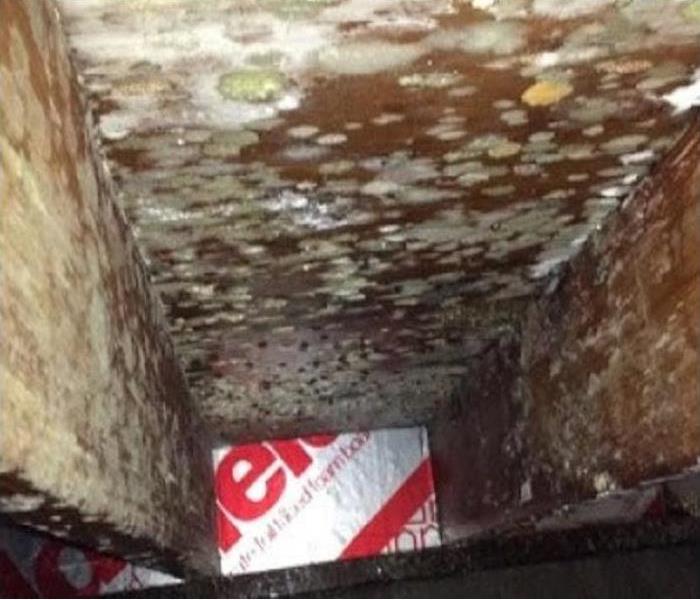Recent Mold Remediation Posts
The Steps of Mold Remediation
10/19/2023 (Permalink)
Mold is a type of fungus. These tiny organisms can be orange, black, green, or white. Most types of mold prefer warm environments, but they can live and grow in any kind of environment. A lot of mold issues start in hard to access areas such as dark basement or attic corners that can be tough to spot. However, once you notice the problem it is time to contact mold cleanup and remediation professionals! We here at SERVPRO of Bennington and Rutland Counties have many years of experience in mold remediation and the proper skills and equipment to get the job done safely for you!
The first step professionals take when preparing for mold cleanup is to establish containment! This could range from closing doors between the affected and non-affected areas or setting up plastic barriers and wearing the proper personal protective equipment (PPE).
PPE includes specialized protective gear such as boots, the proper mask, gloves, and jumpsuits. This gear protects the technicians doing the work but also prevents the spread of mold spores throughout the rest of the home.
Next comes the tear out. Mold spreads and feeds and causes a lot of damage to the structure of your home. For example, when cleaning black mold technicians will tear out dry wall and other materials to prevent further spreading. Once most of the mold affected areas and materials have been removed your technician will then use specialized cleaners and disinfectants to remove the rest of the mold and we will do our best to prevent new growth.
Another important step in preventing further spread of mold is to dry out wet materials. Mold thrives in humidity so by decreasing the level of humidity and moisture new mold spores cannot develop into colonies.
We here at SERVPRO of Bennington and Rutland Counties are here to help you with all your mold remediation needs. We have technicians who are specialized and certified in mold remediation who are eager to help you and return your home to looking “like it never even happened!”
Preventing Mold Growth in your home
9/27/2022 (Permalink)
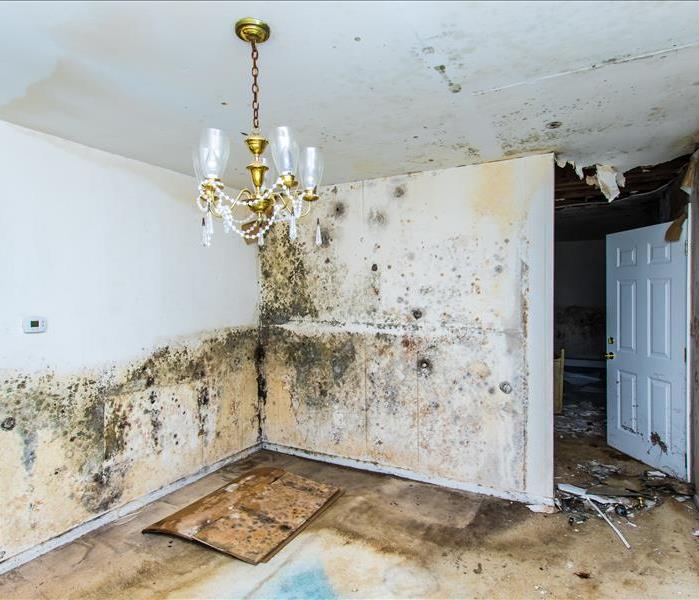 This photo shows mold growth on the walls, floors, and ceiling of a home.
This photo shows mold growth on the walls, floors, and ceiling of a home.
Molds are very common in buildings and homes. Mold will frow in places with a lot of moisture, such as leaks in roofs, windows, or pipes or where there has been flooding. Mold grows well on paper products, cardboard, ceiling tiles, and wood products. Mold can also grow in dust, paints, wallpaper, insulation, drywall, carpet, fabric, and upholstery. Mold can be found both indoors and outdoors. Mold can enter your home through open doorways, windows, vents and heating and air conditioning systems. Mold can appear fuzzy, discolored or in slimy patches that increase in size as they grow. You can usually see or smell a mold problem. The key to preventing mold growth is to identify and control moisture and water problems. Mold spores are everywhere, including your home and they can grow on any surface that has sufficient moisture.
Common sources of moisture are:
- Roof leaks
- Indoor plumbing leaks
- Outdoor drainage problems
- Humidifiers
- Wet clothes drying inside the home
- A clothes dryer venting indoors
- Poor or improper ventilation of heating and cooking appliances
- Condensation on cool surfaces
- Damp basements and crawl spaces
- Steam from a bathroom or kitchen
If you see signs of mold, call us today at (802)-375-1500.
Preventing Mold Growth in your home
9/27/2022 (Permalink)
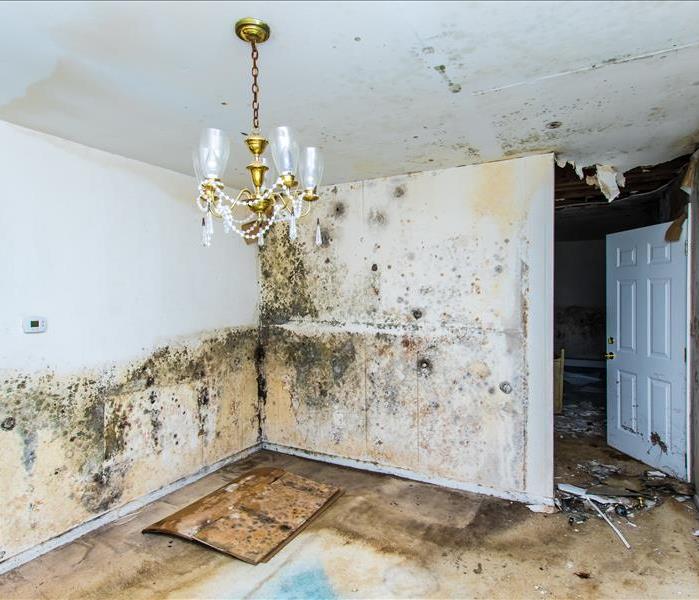 This photo shows mold growth on the walls, floors, and ceiling of a home.
This photo shows mold growth on the walls, floors, and ceiling of a home.
Molds are very common in buildings and homes. Mold will frow in places with a lot of moisture, such as leaks in roofs, windows, or pipes or where there has been flooding. Mold grows well on paper products, cardboard, ceiling tiles, and wood products. Mold can also grow in dust, paints, wallpaper, insulation, drywall, carpet, fabric, and upholstery. Mold can be found both indoors and outdoors. Mold can enter your home through open doorways, windows, vents and heating and air conditioning systems. Mold can appear fuzzy, discolored or in slimy patches that increase in size as they grow. You can usually see or smell a mold problem. The key to preventing mold growth is to identify and control moisture and water problems. Mold spores are everywhere, including your home and they can grow on any surface that has sufficient moisture.
Common sources of moisture are:
- Roof leaks
- Indoor plumbing leaks
- Outdoor drainage problems
- Humidifiers
- Wet clothes drying inside the home
- A clothes dryer venting indoors
- Poor or improper ventilation of heating and cooking appliances
- Condensation on cool surfaces
- Damp basements and crawl spaces
- Steam from a bathroom or kitchen
If you see signs of mold, call us today at (802)-375-1500.
Preventing Mold Growth in your home
9/27/2022 (Permalink)
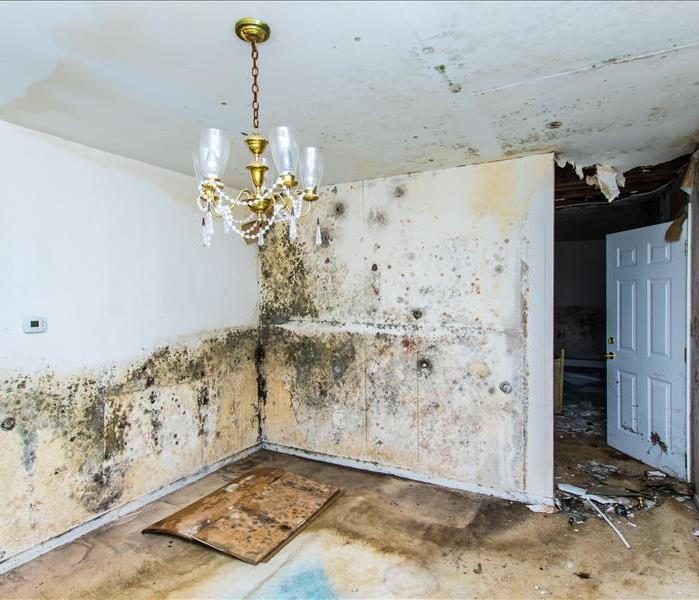 This photo shows mold growth on the walls, floors, and ceiling of a home.
This photo shows mold growth on the walls, floors, and ceiling of a home.
Molds are very common in buildings and homes. Mold will frow in places with a lot of moisture, such as leaks in roofs, windows, or pipes or where there has been flooding. Mold grows well on paper products, cardboard, ceiling tiles, and wood products. Mold can also grow in dust, paints, wallpaper, insulation, drywall, carpet, fabric, and upholstery. Mold can be found both indoors and outdoors. Mold can enter your home through open doorways, windows, vents and heating and air conditioning systems. Mold can appear fuzzy, discolored or in slimy patches that increase in size as they grow. You can usually see or smell a mold problem. The key to preventing mold growth is to identify and control moisture and water problems. Mold spores are everywhere, including your home and they can grow on any surface that has sufficient moisture.
Common sources of moisture are:
- Roof leaks
- Indoor plumbing leaks
- Outdoor drainage problems
- Humidifiers
- Wet clothes drying inside the home
- A clothes dryer venting indoors
- Poor or improper ventilation of heating and cooking appliances
- Condensation on cool surfaces
- Damp basements and crawl spaces
- Steam from a bathroom or kitchen
If you see signs of mold, call us today at (802)-375-1500.
Preventing Mold Growth in your home
9/27/2022 (Permalink)
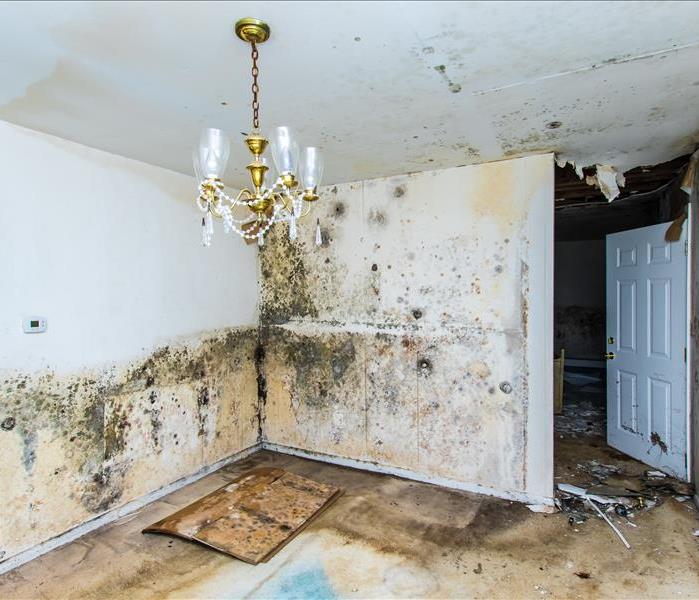 This photo shows mold growth on the walls, floors, and ceiling of a home.
This photo shows mold growth on the walls, floors, and ceiling of a home.
Molds are very common in buildings and homes. Mold will frow in places with a lot of moisture, such as leaks in roofs, windows, or pipes or where there has been flooding. Mold grows well on paper products, cardboard, ceiling tiles, and wood products. Mold can also grow in dust, paints, wallpaper, insulation, drywall, carpet, fabric, and upholstery. Mold can be found both indoors and outdoors. Mold can enter your home through open doorways, windows, vents and heating and air conditioning systems. Mold can appear fuzzy, discolored or in slimy patches that increase in size as they grow. You can usually see or smell a mold problem. The key to preventing mold growth is to identify and control moisture and water problems. Mold spores are everywhere, including your home and they can grow on any surface that has sufficient moisture.
Common sources of moisture are:
- Roof leaks
- Indoor plumbing leaks
- Outdoor drainage problems
- Humidifiers
- Wet clothes drying inside the home
- A clothes dryer venting indoors
- Poor or improper ventilation of heating and cooking appliances
- Condensation on cool surfaces
- Damp basements and crawl spaces
- Steam from a bathroom or kitchen
If you see signs of mold, call us today at (802)-375-1500.
Preventing Mold Growth in your home
9/27/2022 (Permalink)
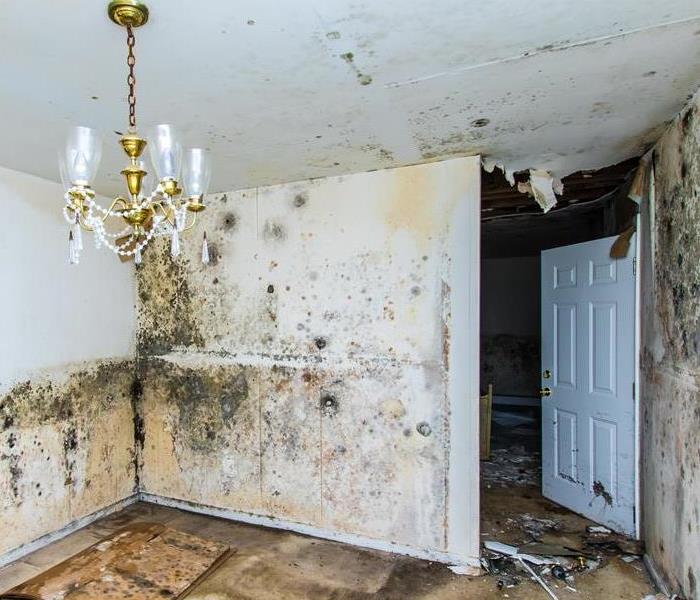 This photo shows mold growth on the walls, floors, and ceiling of a home.
This photo shows mold growth on the walls, floors, and ceiling of a home.
Molds are very common in buildings and homes. Mold will frow in places with a lot of moisture, such as leaks in roofs, windows, or pipes or where there has been flooding. Mold grows well on paper products, cardboard, ceiling tiles, and wood products. Mold can also grow in dust, paints, wallpaper, insulation, drywall, carpet, fabric, and upholstery. Mold can be found both indoors and outdoors. Mold can enter your home through open doorways, windows, vents and heating and air conditioning systems. Mold can appear fuzzy, discolored or in slimy patches that increase in size as they grow. You can usually see or smell a mold problem. The key to preventing mold growth is to identify and control moisture and water problems. Mold spores are everywhere, including your home and they can grow on any surface that has sufficient moisture.
Common sources of moisture are:
- Roof leaks
- Indoor plumbing leaks
- Outdoor drainage problems
- Humidifiers
- Wet clothes drying inside the home
- A clothes dryer venting indoors
- Poor or improper ventilation of heating and cooking appliances
- Condensation on cool surfaces
- Damp basements and crawl spaces
- Steam from a bathroom or kitchen
If you see signs of mold, call us today at (802)-375-1500.
Preventing Mold Growth in your home
9/27/2022 (Permalink)
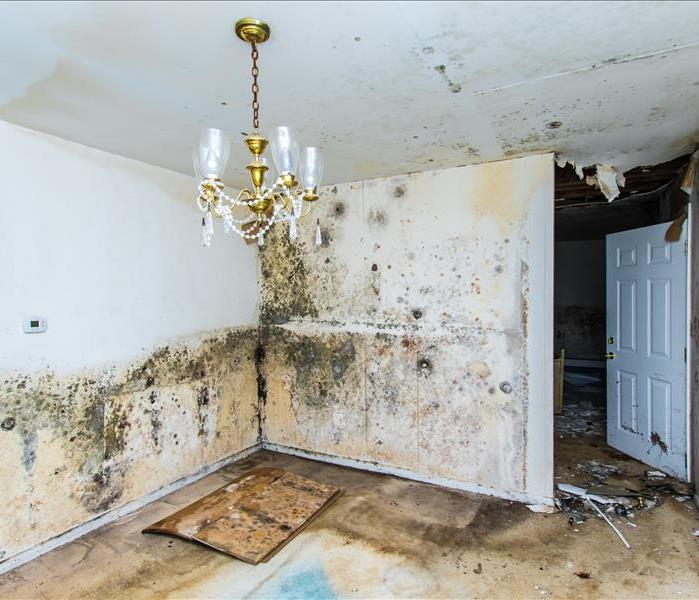 This photo shows mold growth on the walls, floors, and ceiling of a home.
This photo shows mold growth on the walls, floors, and ceiling of a home.
Molds are very common in buildings and homes. Mold will frow in places with a lot of moisture, such as leaks in roofs, windows, or pipes or where there has been flooding. Mold grows well on paper products, cardboard, ceiling tiles, and wood products. Mold can also grow in dust, paints, wallpaper, insulation, drywall, carpet, fabric, and upholstery. Mold can be found both indoors and outdoors. Mold can enter your home through open doorways, windows, vents and heating and air conditioning systems. Mold can appear fuzzy, discolored or in slimy patches that increase in size as they grow. You can usually see or smell a mold problem. The key to preventing mold growth is to identify and control moisture and water problems. Mold spores are everywhere, including your home and they can grow on any surface that has sufficient moisture.
Common sources of moisture are:
- Roof leaks
- Indoor plumbing leaks
- Outdoor drainage problems
- Humidifiers
- Wet clothes drying inside the home
- A clothes dryer venting indoors
- Poor or improper ventilation of heating and cooking appliances
- Condensation on cool surfaces
- Damp basements and crawl spaces
- Steam from a bathroom or kitchen
If you see signs of mold, call us today at (802)-375-1500.
Preventing Mold Growth in your home
9/27/2022 (Permalink)
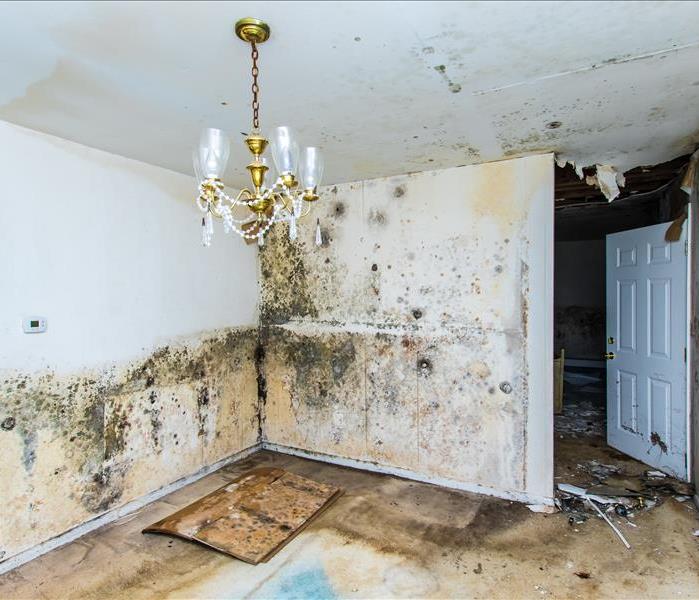 This photo shows mold growth on the walls, floors, and ceiling of a home.
This photo shows mold growth on the walls, floors, and ceiling of a home.
Molds are very common in buildings and homes. Mold will frow in places with a lot of moisture, such as leaks in roofs, windows, or pipes or where there has been flooding. Mold grows well on paper products, cardboard, ceiling tiles, and wood products. Mold can also grow in dust, paints, wallpaper, insulation, drywall, carpet, fabric, and upholstery. Mold can be found both indoors and outdoors. Mold can enter your home through open doorways, windows, vents and heating and air conditioning systems. Mold can appear fuzzy, discolored or in slimy patches that increase in size as they grow. You can usually see or smell a mold problem. The key to preventing mold growth is to identify and control moisture and water problems. Mold spores are everywhere, including your home and they can grow on any surface that has sufficient moisture.
Common sources of moisture are:
- Roof leaks
- Indoor plumbing leaks
- Outdoor drainage problems
- Humidifiers
- Wet clothes drying inside the home
- A clothes dryer venting indoors
- Poor or improper ventilation of heating and cooking appliances
- Condensation on cool surfaces
- Damp basements and crawl spaces
- Steam from a bathroom or kitchen
If you see signs of mold, call us today at (802)-375-1500.
Ways to Reduce the Risk of a Buildup of Moisture and Mold
9/15/2022 (Permalink)
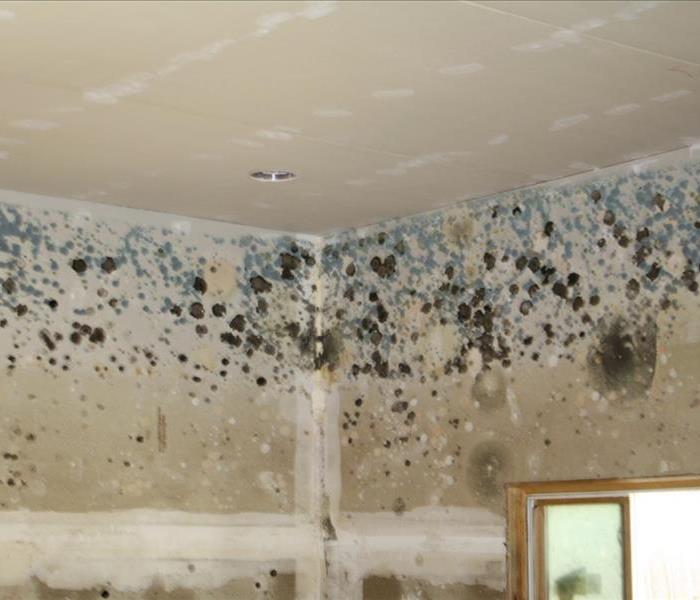 This is what happens when mold is able to grow.
This is what happens when mold is able to grow.
Molds are everywhere in our environment and are a vital part of the ecological system. Molds are a form of fungus. There are many different types, and they can occur both indoors and outdoors.
Reduce the risk of a buildup of moisture and mold by:
- acting quickly if a leak or spillage occurs
- using a dehumidifier to reduce indoor moisture
- leaving windows open, when possible, to allow air to circulate
- using extractor fans to remove moisture during cooking
- avoiding indoor activities that produce moisture, such as drying clothes or using kerosene heaters
- ensuring that all fabrics are thoroughly dry before storing them
- emptying and airing rarely used drawers and closets from time to time
- regularly cleaning so that mold cannot build up on surfaces, dust, or other matter
- using mold-killing products when cleaning the bathroom
- avoiding laying carpets in bathrooms and basements
- maintaining buildings, facilities, gutters, and drains to reduce the risk of leaks
It is not always possible to prevent mold from growing, but regular cleaning and wiping can reduce the risk of it appearing or getting worse.
Different Types of Mold
6/6/2022 (Permalink)
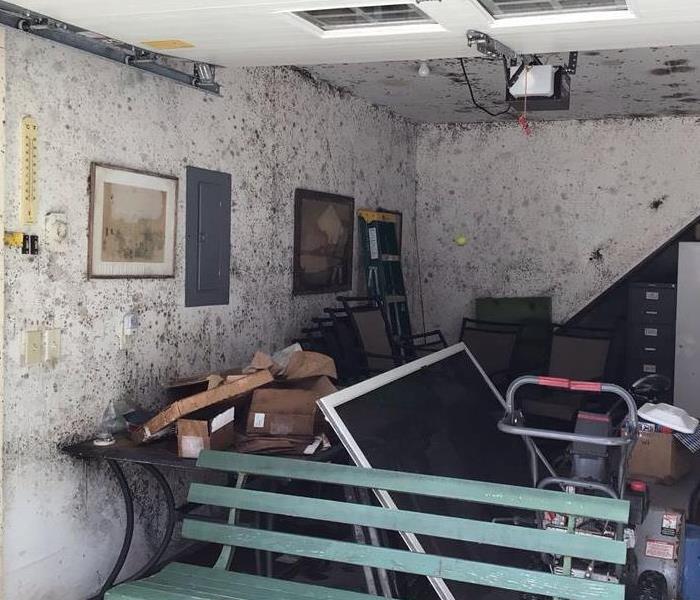 Call us at 802-375-1500!
Call us at 802-375-1500!
Hopefully you will never have to experience having mold in your home or business but sometimes it is unavoidable. Below are 5 common types of mold you may encounter in your home.
- Chaetomium- is usually found on drywall. Typically appears after a water damage that is not properly taken care of or taken care of in the proper amount of time. This type of mold usually makes your home have a musty odor.
- Fusarium- usually grows in colder wetter areas. It is usually found on carpets and similar fabrics. If not taken care of they can cause respiratory infections.
- Alternaria- is one of the most common molds found. You will usually find this type of mold in dark dimly lit areas such sink or shower.
- Serpula Lacrymans- this mold is usually fund outdoors but can also grow on wooden surfaces indoors.
- Stachybotrys Chartarum- more commonly known as black mold. And is usually identified by its musty smell and usually found in areas that are usually damp such as air conditioning pipes.
If you notice mold in your home or business do not hesitate to give SERVPRO of Bennington & Rutland Counties, please give us a call at 802-375-1500.
Mitigation Vs. Remediation
11/5/2021 (Permalink)
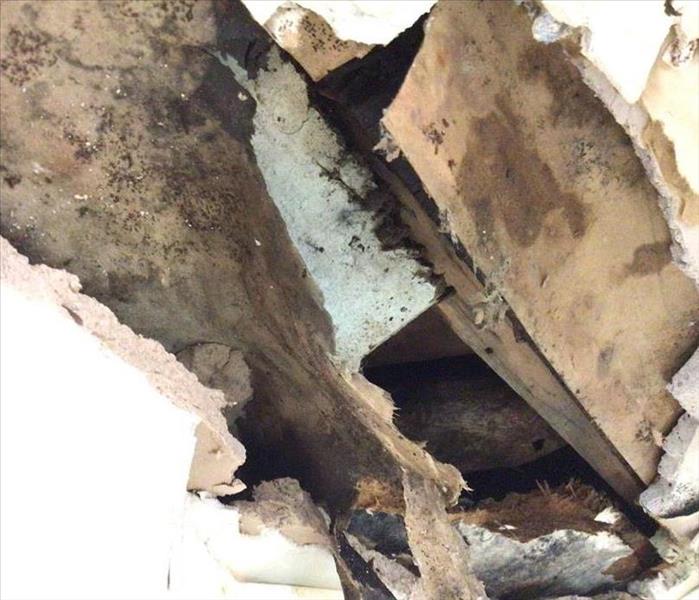 Give us a call if you have a mold problem! 802-375-1500
Give us a call if you have a mold problem! 802-375-1500
SERVPRO of Bennington and Rutland Counties often gets asked the question, “What is the difference between Mitigation and Remediation?”. So, let us help you clear up a lot of your questions when it comes to a disaster that happens either in your home or business.
What is Mitigation?
The actual definition of Mitigation is the action of reducing the severity, seriousness, or painfulness of something. For example, if there was a water loss that happened, and an area was flooded and it had damaged your structure, SERVPRO of Bennington and Rutland Counties would mitigate the loss. This means we remove the effects materials and use drying equipment to help prevent any further damage in the coming future. I.e. Mold Growth.
What is Remediation?
Remediation is the act of remedying something, in reversing or stopping environmental damage. For example, if you have a lot of mold in an area, SERVPRO of Bennington and Rutland Counties will remove the mold and help prevent it from coming back by using industrial strength microbials and equipment to remediate the problem. Mold is a natural spore that can spread throughout an area, so it is best that the problem is dealt with at a professional level.
If you have any questions about the technical terms used in the restoration business, Give us a Call today! 802-375-1500
Mold Containment
9/15/2021 (Permalink)
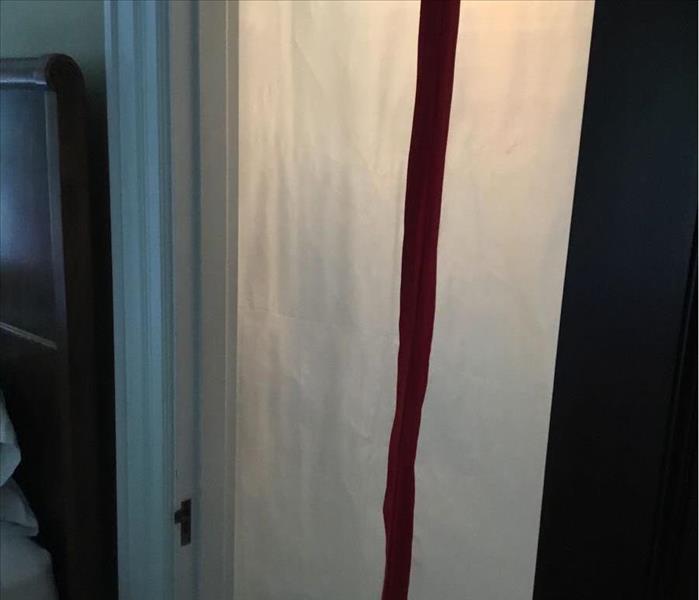
During a recent mold remediation job at a Bennington Vt commercial establishment, we created an area of full containments to separate the mold affected areas from non affected areas. This helps prevent the spread of mold spores throughout the whole facility. Mold has a tendency to grow anywhere there is high moisture and easily can be transported from one room or surface to another. When our trained professionals come in they will use personal protective equipment to protect themselves from being exposed to the mold and also use these containments to prevent further spread of mold. These containments consist of airtight layers of polyethylene that seals off the affected area. The containments act as negative air chambers to isolate the contaminated area with physical barriers and negative air pressure to keep the mold spores from spreading during the cleanup process. Before the mold remediation starts, it is important that the source of moisture (such as a leaky roof) is identified and fixed, otherwise mold may return.
Prevent Mold Buildup In Your Bennington/ Rutland Vermont Home or Business
6/7/2021 (Permalink)
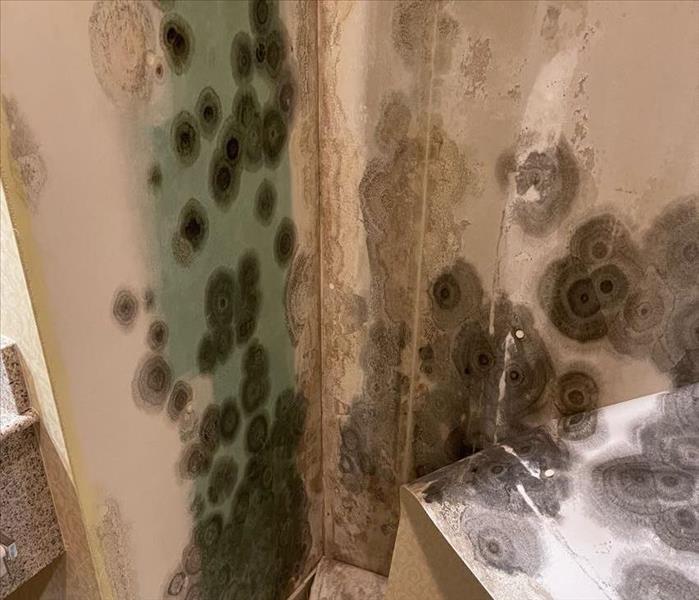 If you experience a mold damage please don't hesitate to give us a call here at SERVPRO of Bennington & Rutland. 802-375-1500.
If you experience a mold damage please don't hesitate to give us a call here at SERVPRO of Bennington & Rutland. 802-375-1500.
Mold is something none of us want in our homes or businesses. Mold spores feed on dust, dirt, or other organic materials so it is important to thoroughly clean your home or business. Below there are three areas to focus on to help to reduce the chances of mold buildup.
- General Surfaces
As stated, above mold can feed on organic material such as dust. Dust gathers around any surface if it is not cleaned frequently. Therefore, if dust is not regularly cleaned and continues to accumulate mold can begin to grow and feed on the dust. It is best to regularly clean your home or business to prevent this from happening.
- Carpets and Rugs
Carpet flooring can trap dirt, soil, and spores which people can bring in from outside. If carpets are not cleaned and left alone these particles can build up and eventually lead to mold buildup and growth. This can be prevented by regular carpet cleaning and vacuuming. Another option in addition to regular cleaning is to install mats at the entrance of your home or building so people can wipe their footwear immediately upon entrance.
- Air Vents
HVAC cleaning is also an area of extreme importance to regularly clean. Dust can gather inside of them and spread throughout your home or building. If mold is found this means that mold can easily through your duct system be spread throughout your home. To prevent this, it is best to get your HVAC system professionally cleaned which is something we here at SERVPRO offer.
The Steps of Mold Remediation
5/11/2021 (Permalink)
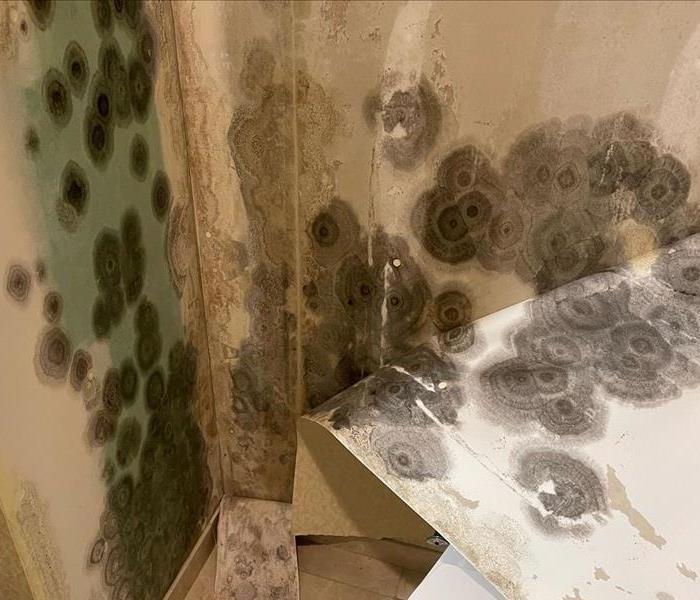 Give us a call for all your Mold Remedation needs. 802-375-1500
Give us a call for all your Mold Remedation needs. 802-375-1500
Mold is a type of fungus. These tiny organisms can be orange, black, green, or white. Most types of mold prefer warm environments, but they can live and grow in any kind of environment. A lot of mold issues start in hard to access areas such as dark basement or attic corners that can be tough to spot. However, once you notice the problem it is time to contact mold cleanup and remediation professionals! We here at SERVPRO of Bennington and Rutland Counties have many years of experience in mold remediation and the proper skills and equipment to get the job done safely for you!
The first step professionals take when preparing for mold cleanup is to establish containment! This could range from closing doors between the affected and non-affected areas or setting up plastic barriers and wearing the proper personal protective equipment (PPE).
PPE includes specialized protective gear such as boots, the proper mask, gloves, and jumpsuits. This gear protects the technicians doing the work but also prevents the spread of mold spores throughout the rest of the home.
Next comes the tear out. Mold spreads and feeds and causes a lot of damage to the structure of your home. For example, when cleaning black mold technicians will tear out dry wall and other materials to prevent further spreading. Once most of the mold affected areas and materials have been removed your technician will then use specialized cleaners and disinfectants to remove the rest of the mold and we will do our best to prevent new growth.
Another important step in preventing further spread of mold is to dry out wet materials. Mold thrives in humidity so by decreasing the level of humidity and moisture new mold spores cannot develop into colonies.
We here at SERVPRO of Bennington and Rutland Counties are here to help you with all your mold remediation needs. We have technicians who are specialized and certified in mold remediation who are eager to help you and return your home to looking "Like it never even happened."
Tips and Tricks for Mold Remediation
4/6/2021 (Permalink)
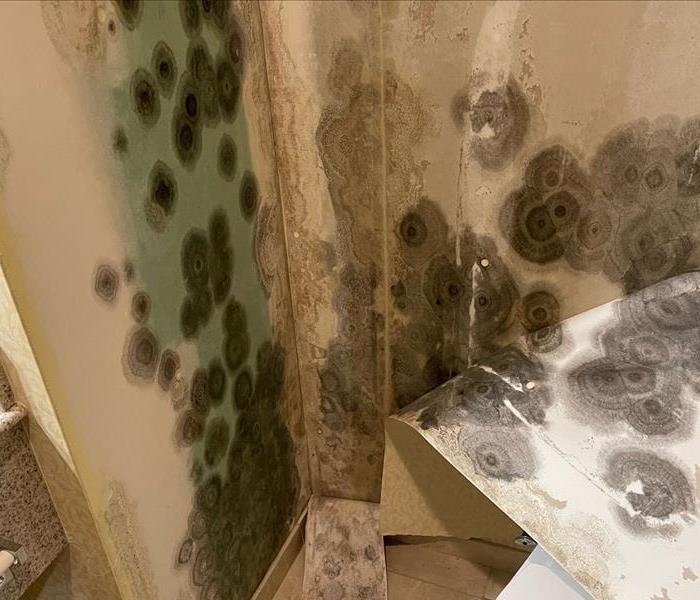 Give us a call for your Mold Remediation 802-375-1500
Give us a call for your Mold Remediation 802-375-1500
Mold is a type of fungus. These tiny organisms can be orange, black, green, or white. Most types of mold prefer warm environments, but they can live and grow in any kind of environment. A lot of mold issues start in hard to access areas such as dark basement or attic corners that can be tough to spot. However, once you notice the problem it is time to contact mold cleanup and remediation professionals! We here at SERVPRO of Bennington and Rutland Counties have many years of experience in mold remediation and the proper skills and equipment to get the job done safely for you!
The first step professionals take when preparing for mold cleanup is to establish containment! This could range from closing doors between the affected and non-affected areas or setting up plastic barriers and wearing the proper personal protective equipment (PPE).
PPE includes specialized protective gear such as boots, the proper mask, gloves, and jumpsuits. This gear protects the technicians doing the work but also prevents the spread of mold spores throughout the rest of the home.
Next comes the tear out. Mold spreads and feeds and causes a lot of damage to the structure of your home. For example, when cleaning black mold technicians will tear out dry wall and other materials to prevent further spreading. Once most of the mold affected areas and materials have been removed your technician will then use specialized cleaners and disinfectants to remove the rest of the mold and we will do our best to prevent new growth.
Another important step in preventing further spread of mold is to dry out wet materials. Mold thrives in humidity so by decreasing the level of humidity and moisture new mold spores cannot develop into colonies.
We here at SERVPRO of Bennington and Rutland Counties are here to help you with all your mold remediation needs. We have technicians who are specialized and certified in mold remediation who are eager to help you and return your home to looking, "Like it never even happened."
Mold Remediation in Bennington County Basement
11/4/2020 (Permalink)
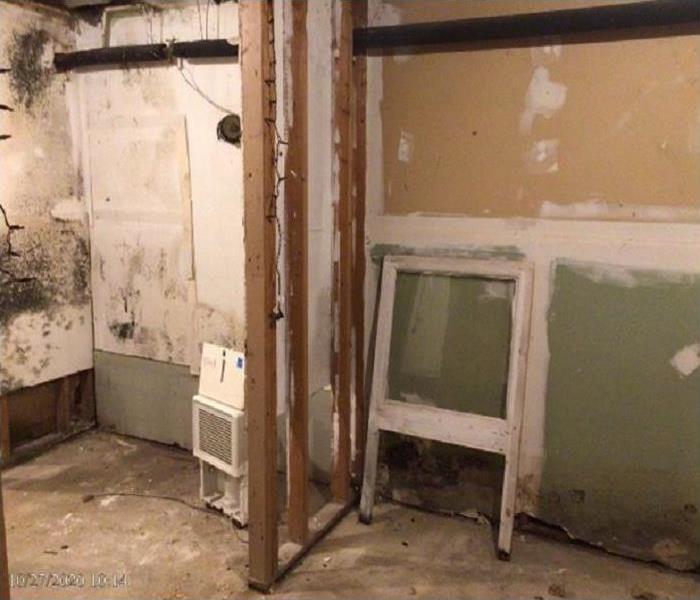 Photo taken from a basement in Bennington County Vermont of black mold.
Photo taken from a basement in Bennington County Vermont of black mold.
SERVPRO of Bennington and Rutland Counties offers mold remediation services. Mold is a type of fungus that can grown in many different types of environments. These small organisms can be black, white, orange, green, or purple. Mold remediation signifigantly reduces the mold spore count back to safe baseline levels. We here at SERVPRO of Bennington and Rutland Counties have all the proper protective equipment as well as products and machinery that are equipped to handle any sort of mold damage you may have in your home or buisiness. Mold tends to grow best in moist environments so here are a few tips to check in your home that could potentially help you from having a mold damage.
Be on the watch for the following in your home:
- Plumbing problems- common leaks such as from a toilet or a sink may go unnoticed and can cause mold growth. Be sure to check areas lie these regularly
- Flooding- if your home is flooded due to heavy rain be sure to have your home dried out by professionals to make sure no moisture is left behind and mold cannot grow. We here at SERVPRO Bennington and Rutland Counties are well equipped to handle your water mitigation needs as well.
- Roof leaks- keep your roof in good condition, making sure there are no leaks. And frequently check you attic yearly for moisture build up.
- Foundation problems- Soil that is around your home should always be sloped downward and away from your home to prevent water from entering your basement and flooding.
- Wipe down walls- after you shower moisture sits on those walls which can lead to mold growth. Best way to prevent this is wiping those walls down with towel or sponge every time after you bathe.
- Air flow- be sure that there is enough air flow in your home, exhaust fans can be used in your kitchens and bathrooms to vent outside your home.
- Humidity- keep the humidity levels in your home less than 50%
- Natural light- allow the sun into your home, mold grows best in dark environments so natural light can help prevent growth.
If you need mold remediation done in your Bennington County home please call us at 802-375-1500 and we will make it "Like it never even happened."
TIPS on How To Prevent Mold Growth in Rutland Vermont
9/14/2020 (Permalink)
SERVPRO of Bennington & Rutland Counties, Vermont has released tips on the six steps to help prevent the growth of mold after water damage has occurred.
14,000 people daily are affected by water damage. It is important to know how to eliminate conditions in which mold may grow and infest the home to help prevent the growth of molds.
All homeowners who have recently experienced water damage should be concerned about mold, as it can grow rapidly. Worse yet, it doesn’t take much water for it grow and it can be much deadlier than expected. The sooner an infestation is taken care of, the better.
Here are six tips to help reduce the likelihood of mold growth:
Remove the water as quickly as possible.
Use a wet or dry vacuum to soak up as much water as possible. This limits the possibility for the mold to grow.
Use fans to dry the floors and carpets faster.
It may take several days for fans to completely dry water damage. Leave them on constantly for at least a few weeks to help circulate cool and fresh air as well as speed up the drying process.
Dehumidify the affected room.
Mold grows in moist, warm and dark areas. Dehumidifying the room helps cool the air and limit mold and mildew growth. Any equipment you can use to dry the air and ground will be useful in mold prevention.
Steam-clean your carpet.
Steam-clean any and all carpets to properly sanitize and wipe out any spores which may have started growing. Any water-damaged carpet padding may need to be replaced, but is still much cheaper than having to entirely re-carpet the house.
Sanitize walls and baseboards.
Anything that has been touched by storm water should immediately be sanitized. Clean any hardwood floors, walls, or other surfaces with soap, water, chlorine, and bleach to minimize mold growth.
Lastly, check affected furniture for any signs of mold growth that may have begun
Check all furniture for water damage, and remove the furniture from wet flooring. Water damage may hide itself under carpets or rugs, so be sure to thoroughly inspect the home.
Even following the above steps, it is likely that a mold infestation may still be present in the home. If any visible signs of mold are noticed, then an infestation/colonization has occurred. For any extensive mold damage situations, it is best to call in the professionals, such as SERVPRO of Bennington & Rutland Counties.
Water damage and mold remediation solutions
SERVPRO is the leading company in fire damage, and mold remediation areas. They are constantly investing in the latest training for mold remediation so that they can meet any customer service needs. Call SERVPRO of Bennington & Rutland Counties at 802-375-1500
Mold Damage Source in Bennington & Rutland Counties
9/11/2020 (Permalink)
Mold is everywhere. The spores that form mold growths are in the air and inside every home and business. The only exceptions are ‘clean rooms’; surgical theaters for example or some electronic assembly chambers.
If you want to understand mold damage in your Rutland, Vermont home, it is necessary to know how mold expands and grows anywhere in the right temperature range with sufficient moisture and food.
Mold starts as a tiny spore, usually airborne. Each one is tinier than a mustard seed, and a mass of thousands is smaller than the head of a pin. When these airborne spores settle on a surface, they remain inert unless they come into contact a source of moisture. The initial amount of water does not need to be more than a few drops, that is all it takes for spores to expand and extend hyphae.
These extensions spread across surfaces to expand the new growth. When they find a food source, hyphae grow into the material; normally construction items like drywall and ceiling tiles. They sustain the growth and speed expansion as well.
Most mold grows at a range of 68 to 86 degrees Fahrenheit. Since this is the temperature range for most homes in North America year-round, fungi growth is a problem in Fall and Winter as well as Spring and Summer. Obviously, the best way to stop mold growth is to turn off the moisture since it is also the starting point of the growth. Then we eliminate the source, be it a leaking pipe, pooled water under a damaged section of roof, a severe flood, or something else.
With the mold halted, we begin cleaning and removal. First, we isolate the area as best as possible; this prevents accidental contamination of other, clean parts of the house. After an initial pass with commercial grade vacuums to pull up loose spores, we remove all building material and personal property with mold. Depending on the item and the amount of mold involved, we clean it on-site, at our facility, or dispose of it. For mold on the structure, we use a variety of anti-fungal agents and tools to kill and remove surface mold. If the spores have grown just below the surface, we remove the piece or cut away the affected section if structural integrity remains uncompromised.
Stopping mold and removing the damage from your home is not a simple task. At, SERVPRO of Bennington & Rutland Counties we have the personnel, training, and equipment needed to ensure we do it as quickly as possible and still provide a safe environment for you and your family to return home.
If you need us, call today at (802) 375-1500.
SERVPRO of Bennington & Rutland Counties Offers FREE Mold Inspections
6/9/2020 (Permalink)
Mold is a vital piece of nature, assisting with the disintegration of natural matter and the recycling of supplements in biological systems. While outdoor mold is fundamental, mold developing inside present’s health risks and can bring about property damage. Molds recreate by method of minor airborne spores that travel essentially anyplace, even in our homes.
Despite the fact that there are hints of mold spores indoors, they require the right "ingredients" to produce mold. Unfortunately, the conditions for mold development are found in many homes: a nourishment source, (for example, drywall, rugs, and wood), warmth, lack of light, enough time to develop, and above all, dampness. Since dampness is a fundamental factor in mold development, here are the most common culprits that cause heightened dampness in homes:
- Flooding can cause a measurable amount of water into your home, bringing on serious water damage and conceivably cause mold development inside 24-48 hours. Calling an expert restoration professional such as SERVPRO of Bennington & Rutland Counties promptly is your best defense with regards to mitigating water damage and preventing mold development.
- Increased humidity can happen in homes from multiple sources — muggy climate, persistent rain, cooking, showering, and so on. To help prevent development of mold growth in your home, ensure your home is all around ventilated and keep the humidity below 55 percent.
- Deficient ventilation leads to increased humidity, and due to this, mold development and different issues like indoor contamination. Try to open entryways as well as windows when viable and to utilize fans as needed.
- Leaking pipes are a typical issue in homes and should be settled promptly. In many cases, leaks are hidden from view, such as inside walls or above the ceiling, so make a point to investigate wall and ceiling stains routinely.
- Roof leaks are additionally a way for water to saturate your home and cause mold. In the event that you see water stains on the ceiling, check for water damage in the attic and have your roof assessed and repaired at the earliest opportunity.
- Condensation happens when warm dampness loaded air interacts with chilly surfaces. Condensation can be seen on walls, windows, solid floors or metal pipes. Reduce condensation by adjusting the humidity in your home.
- Basements give astounding conditions for mold development because of poor ventilation, cooler temperatures (that advance condensation), and incessant water leaks and flooding.
- Mold can also grow in various unexpected areas in the home, which can make mold remediation more difficult.
To schedule a FREE mold inspection contact our professional experts at SERVPRO of Bennington & Rutland Counties at 802-375-1500
We Do Service The Williamstown, North Adams & Clarksburg, Massachusetts Area
5/14/2020 (Permalink)
We are pleased to announce that we do service the Williamstown, North Adams and Clarksburg, Massachusetts area in Water, Fire and Mold Damage Restoration.
Mold is a vital piece of nature, assisting with the disintegration of natural matter and the recycling of supplements in biological systems. While outdoor mold is fundamental, mold developing inside can present health effects and can bring about property damage. Molds recreate by method of minor airborne spores that travel essentially anyplace, even in our homes.
Despite the fact that there are hints of mold spores indoors, they require the right "ingredients" to produce mold. Unfortunately, the conditions for mold development are found in many homes: a nourishment source, (for example, drywall, rugs, and wood), warmth, lack of light, enough time to develop, and above all, dampness. Since dampness is a fundamental factor in mold development, here are the most common culprits that cause heightened dampness in homes:
- Flooding can cause a measurable amount of water into your home, bringing on serious water damage and conceivably cause mold development inside 24-48 hours. Calling an expert restoration professional such as SERVPRO of Bennington & Rutland Counties promptly is your best defense with regards to mitigating water damage and preventing mold development.
- Increased humidity can happen in homes from multiple sources — muggy climate, persistent rain, cooking, showering, and so on. To help prevent development of mold growth in your home, ensure your home is all around ventilated and keep the humidity below 55 percent.
- Deficient ventilation leads to increased humidity, and due to this, mold development and different issues like indoor contamination. Try to open entryways as well as windows when viable and to utilize fans as needed.
- Leaking pipes are a typical issue in homes and should be settled promptly. In many cases, leaks are hidden from view, such as inside walls or above the ceiling, so make a point to investigate wall and ceiling stains routinely.
- Roof leaks are additionally a way for water to saturate your home and cause mold. In the event that you see water stains on the ceiling, check for water damage in the attic and have your roof assessed and repaired at the earliest opportunity.
- Condensation happens when warm dampness loaded air interacts with chilly surfaces. Condensation can be seen on walls, windows, solid floors or metal pipes. Reduce condensation by adjusting the humidity in your home.
- Basements give astounding conditions for mold development because of poor ventilation, cooler temperatures (that advance condensation), and incessant water leaks and flooding.
- Mold can also grow in various unexpected areas in the home, which can make mold remediation more difficult.
To schedule a FREE mold inspection contact our professional experts at SERVPRO of Bennington & Rutland Counties at 802-375-1500
Mold Facts for Bennington County Vermont Residents
4/6/2020 (Permalink)
Microscopic mold spores naturally occur almost everywhere, both outdoors and indoors. This makes it impossible to remove all mold from a home or business. Therefore, mold remediation reduces the mold spore count back to its natural or baseline level. Some restoration businesses advertise “mold removal” and even guarantee to remove all mold, which is a fallacy. Consider the following mold facts:
- Mold is present almost everywhere, indoors and outdoors.
- Mold spores are microscopic and float along in the air and may enter your home through windows, doors, or AC/heating systems or even hitch a ride indoors on your clothing or a pet.
- Mold spores thrive on moisture. Mold spores can quickly grow into colonies when exposed to water. These colonies may produce allergens and irritants.
- Before mold remediation can begin, any sources of water or moisture must be addressed. Otherwise, the mold may return.
- Mold often produces a strong, musty odor and can lead you to possible mold problem areas.
- Even higher-than-normal indoor humidity can support mold growth. Keep indoor humidity below 45 percent.Removing Mold and Mold-Infested Materials.
The mold remediation process depends on the amount of mold growth and the types of surfaces on which the mold appears. We’ll use anti-fungal and antimicrobial treatments to eliminate mold colonies and to help prevent new colonies from forming. It may be necessary to remove and dispose of mold-infested porous materials, like drywall and carpeting, to remediate heavy mold growth.
If your home or business has a mold problem, SERVPRO of Bennington & Rutland Counties can inspect and assess your property and use our specialized training, equipment, and expertise to remediate your mold infestation.
If You See Signs of Mold, Call Us Today – (802)375-1500
Mold Damage Remediation in Bennington & Rutland Counties Vermont
11/16/2019 (Permalink)
Mold damage is a genuine environmental problem that introduces the chance of significant property damage to homes. Anytime there is evidence of water damage or leaky pipes, there is always a chance of mold growth.
It is paramount for homeowners to respond quickly to the first signs of mold. Our specialized team of experts at SERVPRO of Bennington & Rutland Counties come to your location and perform an initial mold inspection to assess the damage. A mold problem tends to reflect a moisture problem in the home. The source of the moisture problem must be addressed to develop a long-term solution to the mold.
Once the mold is identified, we will contain the area and section it off from the rest of the property to prevent the mold spores from becoming airborne. An air filtration system is brought to the site to filter out the air and to remove existing mold spores from the air while our team works. The indoor air quality is a measure of the air in and around the building. The goal at SERVPRO is to eliminate your mold damage problems and return the indoor air quality to a safe level so you can return home. Our team removes the mold and any mold infested building materials. Once the mold is removed, we clean the area and contents that are not damaged by the mold. We apply anti-microbial sanitizing agents to prevent a regrowth of the mold problem.
Any time mold is observed on building materials, on walls, under cabinets or areas with pipes, it is time to call in the experts for a professional opinion. Never try to remove the mold yourself.
Our team of highly trained specialists will provide you with a timeline of the removal process and what to expect with each step along the way. When you suspect or see mold, don't tackle it yourself. Call the mold experts at SERVPRO of Bennington & Rutland Counties to assess the problem at 802-375-1500.
Killing Mold With Ozone
10/11/2019 (Permalink)
To understand the flawed premise of killing mold you must first understand the different characteristics between molds that are (alive) and molds that are dead. Once you do it will be clear why killing mold is not a sensible way to deal with indoor mold growth.
Live Mold
Molds, also known as viable mold are living organisms that require food and water to stay alive. Take away one or the other and mold dies. Molds produce two things; enzymes to digest organic matter and spores to reproduce. Outdoors mold is a vital part of our ecosystem. Without it we would be deep in dead plant matter and other organic materials. But indoors mold can be a real problem when it starts digesting organic materials. As long as mold has a food source and a water source, it can live indefinitely and cause significant damage to anything it comes in contact with.
Dead Mold
When dead mold, also known as non-viable mold has lost its food or water source it dies or goes dormant. At that point, it can no longer cause any further damage to your property. As mold dies it dries out and starts to release spores into the air at a highly accelerated rate, and mold spores – dead or alive – have the same affect on people and animals.
So, if dead mold is just as harmful alive mold – what would be the point in killing it?
Mold spores are organized into three groups according to human responses;
- Allergenic
Most likely to affect those who are already allergic or asthmatic
- Pathogenic
Serious health effects in persons with suppressed immune systems
- Toxigenic
Capable of causing serious health effects in almost anybody
The purpose of mold remediation is never to kill mold, treat mold, heat it, or poison it with gas. Mold remediation means mold removal. Therefore the goal of remediation is always to remove the mold. Mold exposure - dead or alive is a health issue.
Remediation means removing mold. In the simplest of terms, if mold is properly remediated (removed) there should be nothing left to kill.
Contractors who sell high ozone treatments as a method of mold remediation, fail to explain the amount of ozone it takes to kill mold will harm you too!
FROM EPA’s WEB SITE:
Q: Are Ozone Generators Effective in Controlling Indoor Air Pollution?
A: Available scientific evidence shows that concentrations of ozone that do not exceed public health standards, ozone has little potential to remove indoor air contaminants.
For more information from the EPA regarding the use or effectiveness of ozone generators, please visit their web site at: www.epa.gov/iaq/pubs/ozonegen.html
For more specific information regarding mold questions and concerns, call SERVPRO of Bennington & Rutland Counties to speak to a Certified Mold Professional. 802-375-1500
TIPS on How To Prevent Mold Growth in Rutland Vermont
9/14/2019 (Permalink)
SERVPRO of Bennington & Rutland Counties, Vermont has released tips on the six steps to help prevent the growth of mold after water damage has occurred.
14,000 people daily are affected by water damage. It is important to know how to eliminate conditions in which mold may grow and infest the home to help prevent the growth of molds.
All homeowners who have recently experienced water damage should be concerned about mold, as it can grow rapidly. Worse yet, it doesn’t take much water for it grow and it can be much deadlier than expected. The sooner an infestation is taken care of, the better.
Here are six tips to help reduce the likelihood of mold growth:
Remove the water as quickly as possible.
Use a wet or dry vacuum to soak up as much water as possible. This limits the possibility for the mold to grow.
Use fans to dry the floors and carpets faster.
It may take several days for fans to completely dry water damage. Leave them on constantly for at least a few weeks to help circulate cool and fresh air as well as speed up the drying process.
Dehumidify the affected room.
Mold grows in moist, warm and dark areas. Dehumidifying the room helps cool the air and limit mold and mildew growth. Any equipment you can use to dry the air and ground will be useful in mold prevention.
Steam-clean your carpet.
Steam-clean any and all carpets to properly sanitize and wipe out any spores which may have started growing. Any water-damaged carpet padding may need to be replaced, but is still much cheaper than having to entirely re-carpet the house.
Sanitize walls and baseboards.
Anything that has been touched by storm water should immediately be sanitized. Clean any hardwood floors, walls, or other surfaces with soap, water, chlorine, and bleach to minimize mold growth.
Lastly, check affected furniture for any signs of mold growth that may have begun
Check all furniture for water damage, and remove the furniture from wet flooring. Water damage may hide itself under carpets or rugs, so be sure to thoroughly inspect the home.
Even following the above steps, it is likely that a mold infestation may still be present in the home. If any visible signs of mold are noticed, then an infestation/colonization has occurred. For any extensive mold damage situations, it is best to call in the professionals, such as SERVPRO of Bennington & Rutland Counties.
Water damage and mold remediation solutions
SERVPRO is the leading company in fire damage, and mold remediation areas. They are constantly investing in the latest training for mold remediation so that they can meet any customer service needs. Call SERVPRO of Bennington & Rutland Counties at 802-375-1500
Mold Damage Source in Bennington & Rutland Counties
9/11/2019 (Permalink)
Mold is everywhere. The spores that form mold growths are in the air and inside every home and business. The only exceptions are ‘clean rooms’; surgical theaters for example or some electronic assembly chambers.
If you want to understand mold damage in your Rutland, Vermont home, it is necessary to know how mold expands and grows anywhere in the right temperature range with sufficient moisture and food.
Mold starts as a tiny spore, usually airborne. Each one is tinier than a mustard seed, and a mass of thousands is smaller than the head of a pin. When these airborne spores settle on a surface, they remain inert unless they come into contact a source of moisture. The initial amount of water does not need to be more than a few drops, that is all it takes for spores to expand and extend hyphae.
These extensions spread across surfaces to expand the new growth. When they find a food source, hyphae grow into the material; normally construction items like drywall and ceiling tiles. They sustain the growth and speed expansion as well.
Most mold grows at a range of 68 to 86 degrees Fahrenheit. Since this is the temperature range for most homes in North America year-round, fungi growth is a problem in Fall and Winter as well as Spring and Summer. Obviously, the best way to stop mold growth is to turn off the moisture since it is also the starting point of the growth. Then we eliminate the source, be it a leaking pipe, pooled water under a damaged section of roof, a severe flood, or something else.
With the mold halted, we begin cleaning and removal. First, we isolate the area as best as possible; this prevents accidental contamination of other, clean parts of the house. After an initial pass with commercial grade vacuums to pull up loose spores, we remove all building material and personal property with mold. Depending on the item and the amount of mold involved, we clean it on-site, at our facility, or dispose of it. For mold on the structure, we use a variety of anti-fungal agents and tools to kill and remove surface mold. If the spores have grown just below the surface, we remove the piece or cut away the affected section if structural integrity remains uncompromised.
Stopping mold and removing the damage from your home is not a simple task. At, SERVPRO of Bennington & Rutland Counties we have the personnel, training, and equipment needed to ensure we do it as quickly as possible and still provide a safe environment for you and your family to return home.
If you need us, call today at (802) 375-1500.
SERVPRO of Bennington & Rutland Counties Offers FREE Mold Inspections
6/9/2019 (Permalink)
Mold is a vital piece of nature, assisting with the disintegration of natural matter and the recycling of supplements in biological systems. While outdoor mold is fundamental, mold developing inside present’s health risks and can bring about property damage. Molds recreate by method of minor airborne spores that travel essentially anyplace, even in our homes.
Despite the fact that there are hints of mold spores indoors, they require the right "ingredients" to produce mold. Unfortunately, the conditions for mold development are found in many homes: a nourishment source, (for example, drywall, rugs, and wood), warmth, lack of light, enough time to develop, and above all, dampness. Since dampness is a fundamental factor in mold development, here are the most common culprits that cause heightened dampness in homes:
- Flooding can cause a measurable amount of water into your home, bringing on serious water damage and conceivably cause mold development inside 24-48 hours. Calling an expert restoration professional such as SERVPRO of Bennington & Rutland Counties promptly is your best defense with regards to mitigating water damage and preventing mold development.
- Increased humidity can happen in homes from multiple sources — muggy climate, persistent rain, cooking, showering, and so on. To help prevent development of mold growth in your home, ensure your home is all around ventilated and keep the humidity below 55 percent.
- Deficient ventilation leads to increased humidity, and due to this, mold development and different issues like indoor contamination. Try to open entryways as well as windows when viable and to utilize fans as needed.
- Leaking pipes are a typical issue in homes and should be settled promptly. In many cases, leaks are hidden from view, such as inside walls or above the ceiling, so make a point to investigate wall and ceiling stains routinely.
- Roof leaks are additionally a way for water to saturate your home and cause mold. In the event that you see water stains on the ceiling, check for water damage in the attic and have your roof assessed and repaired at the earliest opportunity.
- Condensation happens when warm dampness loaded air interacts with chilly surfaces. Condensation can be seen on walls, windows, solid floors or metal pipes. Reduce condensation by adjusting the humidity in your home.
- Basements give astounding conditions for mold development because of poor ventilation, cooler temperatures (that advance condensation), and incessant water leaks and flooding.
- Mold can also grow in various unexpected areas in the home, which can make mold remediation more difficult.
To schedule a FREE mold inspection contact our professional experts at SERVPRO of Bennington & Rutland Counties at 802-375-1500
We Are Pleased To Announce That We Do Service The Williamstown, North Adams & Clarksburg, Massachusetts Area
5/14/2019 (Permalink)
We are pleased to announce that we do service the Williamstown, North Adams and Clarksburg, Massachusetts area in Water, Fire and Mold Damage Restoration.
Mold is a vital piece of nature, assisting with the disintegration of natural matter and the recycling of supplements in biological systems. While outdoor mold is fundamental, mold developing inside present’s health risks and can bring about property damage. Molds recreate by method of minor airborne spores that travel essentially anyplace, even in our homes.
Despite the fact that there are hints of mold spores indoors, they require the right "ingredients" to produce mold. Unfortunately, the conditions for mold development are found in many homes: a nourishment source, (for example, drywall, rugs, and wood), warmth, lack of light, enough time to develop, and above all, dampness. Since dampness is a fundamental factor in mold development, here are the most common culprits that cause heightened dampness in homes:
- Flooding can cause a measurable amount of water into your home, bringing on serious water damage and conceivably cause mold development inside 24-48 hours. Calling an expert restoration professional such as SERVPRO of Bennington & Rutland Counties promptly is your best defense with regards to mitigating water damage and preventing mold development.
- Increased humidity can happen in homes from multiple sources — muggy climate, persistent rain, cooking, showering, and so on. To help prevent development of mold growth in your home, ensure your home is all around ventilated and keep the humidity below 55 percent.
- Deficient ventilation leads to increased humidity, and due to this, mold development and different issues like indoor contamination. Try to open entryways as well as windows when viable and to utilize fans as needed.
- Leaking pipes are a typical issue in homes and should be settled promptly. In many cases, leaks are hidden from view, such as inside walls or above the ceiling, so make a point to investigate wall and ceiling stains routinely.
- Roof leaks are additionally a way for water to saturate your home and cause mold. In the event that you see water stains on the ceiling, check for water damage in the attic and have your roof assessed and repaired at the earliest opportunity.
- Condensation happens when warm dampness loaded air interacts with chilly surfaces. Condensation can be seen on walls, windows, solid floors or metal pipes. Reduce condensation by adjusting the humidity in your home.
- Basements give astounding conditions for mold development because of poor ventilation, cooler temperatures (that advance condensation), and incessant water leaks and flooding.
- Mold can also grow in various unexpected areas in the home, which can make mold remediation more difficult.
To schedule a FREE mold inspection contact our professional experts at SERVPRO of Bennington & Rutland Counties at 802-375-1500
Mold Facts for Bennington County Vermont Residents
4/2/2019 (Permalink)
 It only takes 48 hours for mold spores to begin to spread. Contact SERVPRO of Bennington & Rutland Counties!
It only takes 48 hours for mold spores to begin to spread. Contact SERVPRO of Bennington & Rutland Counties!
Microscopic mold spores naturally occur almost everywhere, both outdoors and indoors. This makes it impossible to remove all mold from a home or business. Therefore, mold remediation reduces the mold spore count back to its natural or baseline level. Some restoration businesses advertise “mold removal” and even guarantee to remove all mold, which is a fallacy. Consider the following mold facts:
- Mold is present almost everywhere, indoors and outdoors.
- Mold spores are microscopic and float along in the air and may enter your home through windows, doors, or AC/heating systems or even hitch a ride indoors on your clothing or a pet.
- Mold spores thrive on moisture. Mold spores can quickly grow into colonies when exposed to water. These colonies may produce allergens and irritants.
- Before mold remediation can begin, any sources of water or moisture must be addressed. Otherwise, the mold may return.
- Mold often produces a strong, musty odor and can lead you to possible mold problem areas.
- Even higher-than-normal indoor humidity can support mold growth. Keep indoor humidity below 45 percent.Removing Mold and Mold-Infested Materials.
The mold remediation process depends on the amount of mold growth and the types of surfaces on which the mold appears. We’ll use anti-fungal and antimicrobial treatments to eliminate mold colonies and to help prevent new colonies from forming. It may be necessary to remove and dispose of mold-infested porous materials, like drywall and carpeting, to remediate heavy mold growth.
If your home or business has a mold problem, SERVPRO of Bennington & Rutland Counties can inspect and assess your property and use our specialized training, equipment, and expertise to remediate your mold infestation.
If You See Signs of Mold, Call Us Today – (802)375-1500
Mold Damage Remediation in Bennington & Rutland Counties Vermont
11/15/2018 (Permalink)
Mold damage is a genuine environmental problem that introduces the chance of significant property damage to homes. Anytime there is evidence of water damage or leaky pipes, there is always a chance of mold growth.
It is paramount for homeowners to respond quickly to the first signs of mold. Our specialized team of experts at SERVPRO of Bennington & Rutland Counties come to your location and perform an initial mold inspection to assess the damage. A mold problem tends to reflect a moisture problem in the home. The source of the moisture problem must be addressed to develop a long-term solution to the mold.
Once the mold is identified, we will contain the area and section it off from the rest of the property to prevent the mold spores from becoming airborne. An air filtration system is brought to the site to filter out the air and to remove existing mold spores from the air while our team works. The indoor air quality is a measure of the air in and around the building. The goal at SERVPRO is to eliminate your mold damage problems and return the indoor air quality to a safe level so you can return home. Our team removes the mold and any mold infested building materials. Once the mold is removed, we clean the area and contents that are not damaged by the mold. We apply anti-microbial sanitizing agents to prevent a regrowth of the mold problem.
Any time mold is observed on building materials, on walls, under cabinets or areas with pipes, it is time to call in the experts for a professional opinion. Never try to remove the mold yourself.
Our team of highly trained specialists will provide you with a timeline of the removal process and what to expect with each step along the way. When you suspect or see mold, don't tackle it yourself. Call the mold experts at SERVPRO of Bennington & Rutland Counties to assess the problem at 802-375-1500.
TIPS on How To Prevent Mold Growth in Manchester Vermont
9/14/2018 (Permalink)
SERVPRO of Bennington & Rutland Counties, Vermont has released tips on the six steps to help prevent the growth of mold after water damage has occurred.
14,000 people daily are affected by water damage. It is important to know how to eliminate conditions in which mold may grow and infest the home to help prevent the growth of molds.
All homeowners who have recently experienced water damage should be concerned about mold, as it can grow rapidly. Worse yet, it doesn’t take much water for it grow and it can be much deadlier than expected. The sooner an infestation is taken care of, the better.
Here are six tips to help reduce the likelihood of mold growth:
Remove the water as quickly as possible.
Use a wet or dry vacuum to soak up as much water as possible. This limits the possibility for the mold to grow.
Use fans to dry the floors and carpets faster.
It may take several days for fans to completely dry water damage. Leave them on constantly for at least a few weeks to help circulate cool and fresh air as well as speed up the drying process.
Dehumidify the affected room.
Mold grows in moist, warm and dark areas. Dehumidifying the room helps cool the air and limit mold and mildew growth. Any equipment you can use to dry the air and ground will be useful in mold prevention.
Steam-clean your carpet.
Steam-clean any and all carpets to properly sanitize and wipe out any spores which may have started growing. Any water-damaged carpet padding may need to be replaced, but is still much cheaper than having to entirely re-carpet the house.
Sanitize walls and baseboards.
Anything that has been touched by storm water should immediately be sanitized. Clean any hardwood floors, walls, or other surfaces with soap, water, chlorine, and bleach to minimize mold growth.
Lastly, check affected furniture for any signs of mold growth that may have begun
Check all furniture for water damage, and remove the furniture from wet flooring. Water damage may hide itself under carpets or rugs, so be sure to thoroughly inspect the home.
Even following the above steps, it is likely that a mold infestation may still be present in the home. If any visible signs of mold are noticed, then an infestation/colonization has occurred. For any extensive mold damage situations, it is best to call in the professionals, such as SERVPRO of Bennington & Rutland Counties.
Water damage and mold remediation solutions
SERVPRO is the leading company in fire damage, and mold remediation areas. They are constantly investing in the latest training for mold remediation so that they can meet any customer service needs. Call SERVPRO of Bennington & Rutland Counties at 802-375-1500
Mold Damage Source in Bennington & Rutland Counties
9/11/2018 (Permalink)
Moisture Removal Begins Mild Damage Remediation in Bennington & Rutland Counties
Mold is everywhere. The spores that form mold growths are in the air and inside every home and business. The only exceptions are ‘clean rooms’; surgical theaters for example or some electronic assembly chambers.
If you want to understand mold damage in your home Rutland, Vermont home, it is necessary to know how mold expands and grows anywhere in the right temperature range with sufficient moisture and food.
Mold starts as a tiny spore, usually airborne. Each one is tinier than a mustard seed, and a mass of thousands is smaller than the head of a pin. When these airborne spores settle on a surface, they remain inert unless they come into contact a source of moisture. The initial amount of water does not need to be more than a few drops, that is all it takes for spores to expand and extend hyphae.
These extensions spread across surfaces to expand the new growth. When they find a food source, hyphae grow into the material; normally construction items like drywall and ceiling tiles. They sustain the growth and speed expansion as well.
Most mold grows at a range of 68 to 86 degrees Fahrenheit. Since this is the temperature range for most homes in North America year-round, fungi growth is a problem in Fall and Winter as well as Spring and Summer. Obviously, the best way to stop mold growth is to turn off the moisture since it is also the starting point of the growth. Then we eliminate the source, be it a leaking pipe, pooled water under a damaged section of roof, a severe flood, or something else.
With the mold halted, we begin cleaning and removal. First, we isolate the area as best as possible; this prevents accidental contamination of other, clean parts of the house. After an initial pass with commercial grade vacuums to pull up loose spores, we remove all building material and personal property with mold. Depending on the item and the amount of mold involved, we clean it on-site, at our facility, or dispose of it. For mold on the structure, we use a variety of antifungal agents and tools to kill and remove surface mold. If the spores have grown just below the surface, we remove the piece or cut away the affected section if structural integrity remains uncompromised.
Stopping mold and removing the damage from your home is not a simple task. At, SERVPRO of Bennington & Rutland Counties we have the personnel, training, and equipment needed to ensure we do it as quickly as possible and still provide a safe environment for you and your family to return home.
If you need us, call today at (802) 375-1500.
Does Your Rutland, Vermont Home Have a Mold Problem?
7/13/2018 (Permalink)
We respond to many requests for mold damage restoration throughout the Rutland, Vermont area. There is no reason to be embarrassed by its presence, or attempt to clean the affected area yourself without the proper tools or equipment. You have IICRC Certified technicians available around the clock to provide you with the services needed to regain control over your indoor living environment.
Whether you have a small patch of mold on your bathroom ceiling or an entire floor of your home affected by growth, SERVPRO of Bennington & Rutland Counties technicians can help. We can help you get the problem under control while also providing you with any necessary repairs that help return your home to a quality pre-damage condition.
Not sure if mold is the actual problem? SERVPRO of Bennington & Rutland Counties can inspect your home, rule mold out, and help you discover the true nature of the problem affecting your home. Our technicians are qualified to perform a variety of repairs, or restore any section of your home, regardless of its condition. If mold proves to be the issue at hand, you already have qualified mold remediation specialists on site to address the situation appropriately.
SERVPRO of Bennington & Rutland Counties use negative airflow machines. We then remove any saturated materials, disposing and transporting all affected materials. Our cleaning technicians use a variety of equipment and cleaning supplies to decontaminate the entire area. Making it ready for the installation of new materials and any additional repairs.
Receive the professional, courteous services you deserve by calling SERVPRO of Bennington & Rutland Counties today. We are available 24/7, 802-375-1500
SERVPRO of Bennington & Rutland Counties Offers FREE Mold Inspections
6/19/2018 (Permalink)
Mold is a vital piece of nature, assisting with the disintegration of natural matter and the recycling of supplements in biological systems. While outdoor mold is fundamental, mold developing inside present’s health risks and can bring about property damage. Molds recreate by method of minor airborne spores that travel essentially anyplace, even in our homes.
Despite the fact that there are hints of mold spores indoors, they require the right "ingredients" to produce mold. Unfortunately, the conditions for mold development are found in many homes: a nourishment source, (for example, drywall, rugs, and wood), warmth, lack of light, enough time to develop, and above all, dampness. Since dampness is a fundamental factor in mold development, here are the most common culprits that cause heightened dampness in homes:
- Flooding can cause a measurable amount of water into your home, bringing on serious water damage and conceivably cause mold development inside 24-48 hours. Calling an expert restoration professional such as SERVPRO of Bennington & Rutland Counties promptly is your best defense with regards to mitigating water damage and preventing mold development.
- Increased humidity can happen in homes from multiple sources — muggy climate, persistent rain, cooking, showering, and so on. To help prevent development of mold growth in your home, ensure your home is all around ventilated and keep the humidity below 55 percent.
- Deficient ventilation leads to increased humidity, and due to this, mold development and different issues like indoor contamination. Try to open entryways as well as windows when viable and to utilize fans as needed.
- Leaking pipes are a typical issue in homes and should be settled promptly. In many cases, leaks are hidden from view, such as inside walls or above the ceiling, so make a point to investigate wall and ceiling stains routinely.
- Roof leaks are additionally a way for water to saturate your home and cause mold. In the event that you see water stains on the ceiling, check for water damage in the attic and have your roof assessed and repaired at the earliest opportunity.
- Condensation happens when warm dampness loaded air interacts with chilly surfaces. Condensation can be seen on walls, windows, solid floors or metal pipes. Reduce condensation by adjusting the humidity in your home.
- Basements give astounding conditions for mold development because of poor ventilation, cooler temperatures (that advance condensation), and incessant water leaks and flooding.
- Mold can also grow in various unexpected areas in the home, which can make mold remediation more difficult.
To schedule a FREE mold inspection contact our professional experts at SERVPRO of Bennington & Rutland Counties at 802-375-1500
Mold Facts for Bennington County Vermont Residents
4/2/2018 (Permalink)
 It only takes 48 hours for mold spores to begin to spread.
It only takes 48 hours for mold spores to begin to spread.
Microscopic mold spores naturally occur almost everywhere, both outdoors and indoors. This makes it impossible to remove all mold from a home or business. Therefore, mold remediation reduces the mold spore count back to its natural or baseline level. Some restoration businesses advertise “mold removal” and even guarantee to remove all mold, which is a fallacy. Consider the following mold facts:
- Mold is present almost everywhere, indoors and outdoors.
- Mold spores are microscopic and float along in the air and may enter your home through windows, doors, or AC/heating systems or even hitch a ride indoors on your clothing or a pet.
- Mold spores thrive on moisture. Mold spores can quickly grow into colonies when exposed to water. These colonies may produce allergens and irritants.
- Before mold remediation can begin, any sources of water or moisture must be addressed. Otherwise, the mold may return.
- Mold often produces a strong, musty odor and can lead you to possible mold problem areas.
- Even higher-than-normal indoor humidity can support mold growth. Keep indoor humidity below 45 percent.Removing Mold and Mold-Infested Materials.
The mold remediation process depends on the amount of mold growth and the types of surfaces on which the mold appears. We’ll use anti-fungal and antimicrobial treatments to eliminate mold colonies and to help prevent new colonies from forming. It may be necessary to remove and dispose of mold-infested porous materials, like drywall and carpeting, to remediate heavy mold growth.
If your home or business has a mold problem, SERVPRO of Bennington & Rutland Counties can inspect and assess your property and use our specialized training, equipment, and expertise to remediate your mold infestation.
If You See Signs of Mold, Call Us Today – (802)375-1500
Air Duct Cleaning servicing Manchester, Vermont
11/8/2017 (Permalink)
 Before and After Air Ducts Cleaned in Manchester, Vermont.
Before and After Air Ducts Cleaned in Manchester, Vermont.
SERVPRO of Bennington & Rutland Counties cleaning air ducts in Manchester and Dorset, Vermont.
SERVPRO of Bennington & Rutland Counties offers HVAC air duct cleaning using negative pressure to the Manchester, VT area.
Cleaning Under Negative Pressure
As cleaning agitation proceeds inside the ductwork, dislodged particulates are sucked out of the duct and into the vacuum receptacle. Working under negative pressure prevents contamination of household air during the cleaning process as well as later, when loosened contaminants left in the ducts might infiltrate living spaces after the system is restarted. The vacuum force itself also enhances the cleaning action of the tools.
The benefits of servicing your HVAC unit include:
- Helps to restore peak energy efficiency.
- May help to eliminate offensive odors.
- Helps reduce the potential for mold growth.
For more information on HVAC and air duct cleaning, or for a FREE estimate call us today at(802) 375-1500.
TIPS on How To Prevent Mold Growth in Vermont
9/14/2017 (Permalink)
 Mold Remediation
Mold Remediation
SERVPRO of Bennington & Rutland Counties, Vermont has released tips on the six steps to help prevent the growth of mold after water damage has occurred.
14,000 people daily are affected by water damage. It is important to know how to eliminate conditions in which mold may grow and infest the home to help prevent the growth of molds.
All homeowners who have recently experienced water damage should be concerned about mold, as it can grow rapidly. Worse yet, it doesn’t take much water for it grow and it can be much deadlier than expected. The sooner an infestation is taken care of, the better.
Here are six tips to help reduce the likelihood of mold growth:
Remove the water as quickly as possible.
Use a wet or dry vacuum to soak up as much water as possible. This limits the possibility for the mold to grow.
Use fans to dry the floors and carpets faster.
It may take several days for fans to completely dry water damage. Leave them on constantly for at least a few weeks to help circulate cool and fresh air as well as speed up the drying process.
Dehumidify the affected room.
Mold grows in moist, warm and dark areas. Dehumidifying the room helps cool the air and limit mold and mildew growth. Any equipment you can use to dry the air and ground will be useful in mold prevention.
Steam-clean your carpet.
Steam-clean any and all carpets to properly sanitize and wipe out any spores which may have started growing. Any water-damaged carpet padding may need to be replaced, but is still much cheaper than having to entirely re-carpet the house.
Sanitize walls and baseboards.
Anything that has been touched by storm water should immediately be sanitized. Clean any hardwood floors, walls, or other surfaces with soap, water, chlorine, and bleach to minimize mold growth.
Lastly, check affected furniture for any signs of mold growth that may have begun
Check all furniture for water damage, and remove the furniture from wet flooring. Water damage may hide itself under carpets or rugs, so be sure to thoroughly inspect the home.
Even following the above steps, it is likely that a mold infestation may still be present in the home. If any visible signs of mold are noticed, then an infestation/colonization has occurred. For any extensive mold damage situations, it is best to call in the professionals, such as SERVPRO of Bennington & Rutland Counties.
Water damage and mold remediation solutions
SERVPRO is the leading company in fire damage, and mold remediation areas. They are constantly investing in the latest training for mold remediation so that they can meet any customer service needs. Call SERVPRO of Bennington & Rutland Counties at 802-375-1500
Mold Damage Source in Bennington & Rutland Counties
9/11/2017 (Permalink)
Moisture Removal Begins Mild Damage Remediation in Bennington & Rutland Counties
Mold is everywhere. The spores that form mold growths are in the air and inside every home and business. The only exceptions are ‘clean rooms’; surgical theaters for example or some electronic assembly chambers.
If you want to understand mold damage in your home, it is necessary to know how mold expands and grows anywhere in the right temperature range with sufficient moisture and food.
Mold starts as a tiny spore, usually airborne. Each one is tinier than a mustard seed, and a mass of thousands is smaller than the head of a pin. When these airborne spores settle on a surface, they remain inert unless they come into contact a source of moisture. The initial amount of water does not need to be more than a few drops, that is all it takes for spores to expand and extend hyphae.
These extensions spread across surfaces to expand the new growth. When they find a food source, hyphae grow into the material; normally construction items like drywall and ceiling tiles. They sustain the growth and speed expansion as well.
Most mold grows at a range of 68 to 86 degrees Fahrenheit. Since this is the temperature range for most homes in North America year-round, fungi growth is a problem in Fall and Winter as well as Spring and Summer. Obviously, the best way to stop mold growth is to turn off the moisture since it is also the starting point of the growth. Then we eliminate the source, be it a leaking pipe, pooled water under a damaged section of roof, a severe flood, or something else.
With the mold halted, we begin cleaning and removal. First, we isolate the area as best as possible; this prevents accidental contamination of other, clean parts of the house. After an initial pass with commercial grade vacuums to pull up loose spores, we remove all building material and personal property with mold. Depending on the item and the amount of mold involved, we clean it on-site, at our facility, or dispose of it.
For mold on the structure, we use a variety of antifungal agents and tools to kill and remove surface mold. If the spores have grown just below the surface, we remove the piece or cut away the affected section if structural integrity remains uncompromised.
Stopping mold and removing the damage from your home is not a simple task. At, SERVPRO of Bennington & Rutland Counties we have the personnel, training, and equipment needed to ensure we do it as quickly as possible and still provide a safe environment for you and your family to return home. If you need us, call today at (802) 375-1500.
Rutland County Vermont Residents: Follow These Mold Safety Tips If You Suspect Mold
7/13/2017 (Permalink)
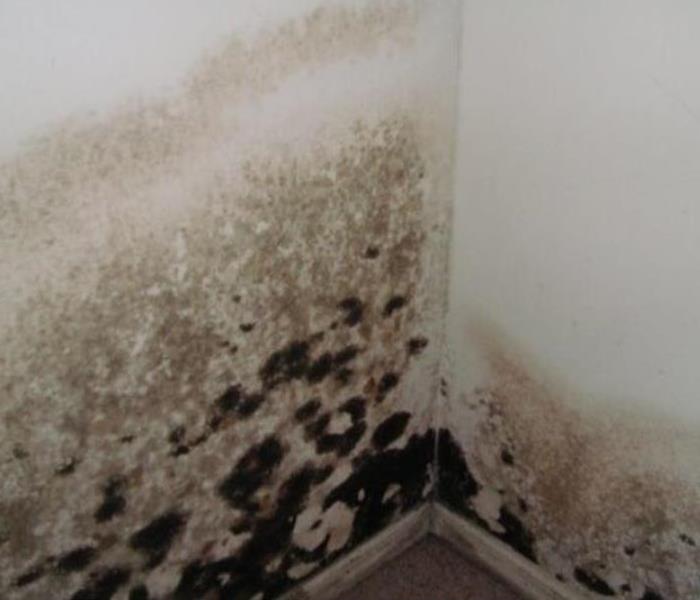 Be careful! Without proper training, you could be spreading mold throughout your home.
Be careful! Without proper training, you could be spreading mold throughout your home.
If you see visible mold, do not disturb it. You can inadvertently spread the mold infestation throughout your home. When mold is disturbed, the mold can release microscopic mold spores which become airborne and can circulate inside your home.
What to Do:
- Stay out of affected areas.
- Turn off the HVAC system and fans.
- Contact SERVPRO of Bennington & Rutland Counties for mold remediation services.
What Not to Do:
- Don’t touch or disturb the mold.
- Don’t blow air across any surfaces with visible or suspected mold growth.
- Don’t attempt to dry the area yourself.
- Don’t spray bleach or other disinfectants on the mold.
About Our Mold Remediation Services
SERVPRO of Bennington & Rutland Countiesspecializes in mold cleanup and restoration, in fact, it’s a cornerstone of our business. Our crews are highly trained restoration professionals that use specialized equipment and techniques to properly re-mediate your mold problem quickly and safely.
If You See Signs of Mold, Call Us Today – 802-375-1500
Causes of Mold in Your Home
6/20/2017 (Permalink)
Mold is a vital piece of nature, assisting with the disintegration of natural matter and the recycling of supplements in biological systems. While outdoor mold is fundamental, mold developing inside present’s health risks and can bring about property damage. Molds recreate by method of minor airborne spores that travel essentially anyplace, even in our homes.
Despite the fact that there are hints of mold spores indoors, they require the right "ingredients" to produce mold. Unfortunately, the conditions for mold development are found in many homes: a nourishment source, (for example, drywall, rugs, and wood), warmth, lack of light, enough time to develop, and above all, dampness. Since dampness is a fundamental factor in mold development, here are the most common culprits that cause heightened dampness in homes:
- Flooding can cause a measurable amount of water into your home, bringing on serious water damage and conceivably cause mold development inside 24-48 hours. Calling an expert restoration professional such as SERVPRO of Bennington & Rutland Counties promptly is your best defense with regards to mitigating water damage and preventing mold development.
- Increased humidity can happen in homes from multiple sources — muggy climate, persistent rain, cooking, showering, and so on. To help prevent development of mold growth in your home, ensure your home is all around ventilated and keep the humidity below 55 percent.
- Deficient ventilation leads to increased humidity, and due to this, mold development and different issues like indoor contamination. Try to open entryways as well as windows when viable and to utilize fans as needed.
- Leaking pipes are a typical issue in homes and should be settled promptly. In many cases, leaks are hidden from view, such as inside walls or above the ceiling, so make a point to investigate wall and ceiling stains routinely.
- Roof leaks are additionally a way for water to saturate your home and cause mold. In the event that you see water stains on the ceiling, check for water damage in the attic and have your roof assessed and repaired at the earliest opportunity.
- Condensation happens when warm dampness loaded air interacts with chilly surfaces. Condensation can be seen on walls, windows, solid floors or metal pipes. Reduce condensation by adjusting the humidity in your home.
- Basements give astounding conditions for mold development because of poor ventilation, cooler temperatures (that advance condensation), and incessant water leaks and flooding.
- Mold can also grow in various unexpected areas in the home, which can make mold remediation more difficult.
For professional mold removal, as well as fire and water restoration services, contact the professional experts at SERVPRO of Bennington & Rutland Counties at 802-375-1500
Is your Contractor Insured for Mold Remediation?
9/8/2016 (Permalink)
Before spending thousands of dollars to have your home or business Mold Remediated consider the following:
Don't be misled by vague advertising and low or free mold inspection fees without the experience, insurance coverage and certifications to back them up.
We here at SERVPRO of Bennington & Rutland Counties are highly trained Mold Remediation Technicians.
We Use Advanced Mold Remediation Techniques and Equipment.
We invest in the latest equipment and ongoing mold remediation training because it helps us restore your home or business quickly and effectively. We will isolate the affected area using physical barriers and a negative pressure chamber.
If You See Signs of Mold,
Call Us Today – (802) 375-1500
Team SERVPRO Can Help With Mold Damage
6/24/2016 (Permalink)
 Areas With Mold Damage Need To Be Sectioned Off From Rest Of House
Areas With Mold Damage Need To Be Sectioned Off From Rest Of House
Mold damage is a genuine environmental problem that introduces the chance of significant property damage to homes. Anytime there is evidence of water damage or leaky pipes, there is always a chance of mold growth. It is paramount for homeowners to respond quickly to the first signs of mold. Our specialized team of experts at SERVPRO of Bennington & Rutland Counties come to your location and perform an initial mold inspection to assess the damage. A mold problem tends to reflect a moisture problem in the home. The source of the moisture problem must be addressed to develop a long-term solution to the mold.
Once the mold is identified, we will contain the area and section it off from the rest of the property to prevent the mold spores from becoming airborne. An air filtration system is brought to the site to filter out the air and to remove existing mold spores from the air while our team works. The indoor air quality is a measure of the air in and around the building. The goal at SERVPRO is to eliminate your mold damage problems and return the indoor air quality to a safe level so you can return home. Our team removes the mold and any mold infested building materials. Once the mold is removed, we clean the area and contents that are not damaged by the mold. We apply anti-microbial sanitizing agents to prevent a regrowth of the mold problem.
There are various types of mold that can grow in homes. One of the most dangerous types of mold is known as toxic mold. Mold can be black in color or show up in other colors such as green. All mold is potentially dangerous. However, this is best determined by our team of specially trained experts.
Any time mold is observed on building materials, on walls, under cabinets or areas with pipes, it is time to call in the experts for a professional opinion. Never try to remove the mold yourself.
Our team of highly trained specialists will provide you with a timeline of the removal process and what to expect with each step along the way. When you suspect or see mold, don't tackle it yourself. Call the mold experts at SERVPRO of Bennington & Rutland Counties to assess the problem at 802-375-1500.
Mold Inspection - SERVPRO of Bennington & Rutland Counties
6/10/2016 (Permalink)
 It's Mold Season here in Southern Vermont. This house in Bennington had severe mold growth. Servpro of Bennington/Rutland Counties are here to help!
It's Mold Season here in Southern Vermont. This house in Bennington had severe mold growth. Servpro of Bennington/Rutland Counties are here to help!
SERVPRO of Bennington and Rutland Counties located in Manchester, Vermont will perform a visual Mold Inspection report along with moisture readings for a nominal service charge. This report will also include an estimate for our Mold Remediation services.
- Our inspection includes a full visual including moisture meter readings and a comprehensive written report including documented photographs of the mold growth.
- Our Mold Inspections look for evidence of past or current Mold Growth. Past mold growth may indicate a water problem which will come back when certain conditions return such as a recurring leak.
- We will look for mold within the building, and in other areas where mold growth is undesirable, including areas where mold growth could be causing structural issues such as wood decay in crawlspaces.
- We take moisture meter readings during the Mold inspection. Water is essential for mold growth. Without a source of water, you will not have mold growth
If you suspect that your home or business has a mold problem, our Professional team can inspect and assess your property. If mold is found, they have the training, equipment, and expertise to handle the situation.
SERVPRO of Bennington & Rutland Counties
802-375-1500
We Provide Mold Inspections for your Home or Business
2/6/2015 (Permalink)
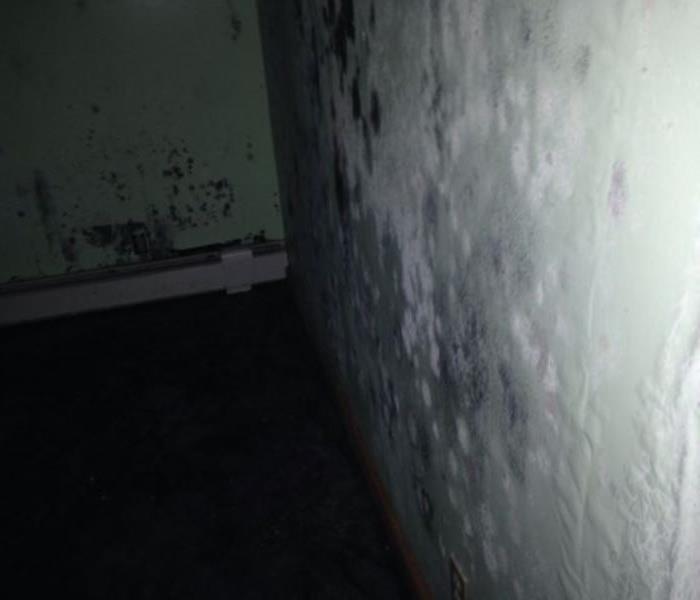 We Provide Mold Inspections for Manchester, Arlington, Shaftsbury,Danby, Dorset, Rupert, Wells, Bondville, Stratton, Winhall, Weston, Wallingford
We Provide Mold Inspections for Manchester, Arlington, Shaftsbury,Danby, Dorset, Rupert, Wells, Bondville, Stratton, Winhall, Weston, Wallingford
SERVPRO of Bennington and Rutland Counties can assess your property if you suspect that your home or business has a mold problem. If mold is found, we have the training, equipment, and expertise to handle the situation.
- Our fee of $150 is credited towards the mold remediation work that we do on your behalf. Our inspection includes a full visual including moisture meter readings and a comprehensive written report including documented photographs of the mold growth.
- Our Mold Inspections look for evidence of past or current mold growth. Past mold growth may indicate a water problem which will come back when certain conditions return such as a recurring leak.
- We will look for mold within the building, and in other areas where mold growth is undesirable, including areas where mold growth could be causing structural issues such as wood decay in crawlspaces.
- We take moisture meter readings during the Mold inspection. Water is essential for mold growth. Without a source of water, you will not have mold growth
If you suspect that your home or business has a mold problem, our Professional team can inspect and assess your property. If mold is found, they have the training, equipment, and expertise to handle the situation.
SERVPRO of Bennington & Rutland Counties
802-375-1500
Mold Removal, Clean-Up and Restoration in Londonderry, Vermont by SERVPRO of Bennnington & Rutland Counties, Vermont
1/9/2015 (Permalink)
Mold Removal, Clean-Up and Restoration
Any home or business can quickly become infested with mold with the introduction of a water source, like a roof or plumbing leak. Mold can spread throughout a property in as little as 48-72 hours, and can produce allergens and irritants that have the potential to cause other health effects.
If you suspect that your home or business has a mold problem, SERVPRO Franchise Professionals can inspect and assess your property. If mold is found, they have the training, equipment, and expertise to handle the situation.
SERVPRO of Bennington & Rutland Counties Professionals
If You See Signs of Mold, Call 802-375-1500
Understanding Mold
Microscopic mold spores exist almost everywhere, outdoors and indoors, making it impossible to remove all mold from a home or business. Some restoration businesses advertise “mold removal” and even guarantee to remove all mold, which is a fallacy. Consider the following mold facts:
- Mold is present almost everywhere, indoors and outdoors.
- Mold spores are microscopic and float along in the air, and may enter your home through windows, doors, or AC/heating systems or even hitch a ride indoors on your clothing or on a pet.
- Mold spores thrive on moisture. Mold spores can quickly grow into colonies when exposed to water.
- Before mold remediation can begin, any sources of water or moisture must be addressed. Otherwise, the mold may return.
- Mold often produces a strong, musty odor and can lead you to possible mold problem areas.
- Even higher-than-normal indoor humidity can support mold growth. Keep indoor humidity below 45 percent.
Why Choose SERVPRO of Bennington & Rutland Counties?
They’re Faster to Any Size Disaster
SERVPRO Franchise Professionals are dedicated to responding immediately when you contact them. A fast response lessens the damage, limits further damage, and reduces cost.
They’re Highly Trained Mold Remediation Specialists
They specialize in water and mold damage restoration, the cornerstone of our business. SERVPRO Franchise Professionals have the training and expertise to safely handle any mold situation.
- Applied Microbial Remediation Specialist
- Water Damage Restoration Technician
- Applied Structural Drying Technician
They Use Advanced Mold Remediation Techniques and Equipment
SERVPRO Franchise Professionals use advanced equipment to detect the source of water feeding the mold. Next, they isolate the affected area using a negative air pressure chamber.
SERVPRO of Bennington & Rutland Counties
PO Box 2167
Manchester Center, VT 05255
802-375-1500
Mold Inspections - SERVPRO of Bennington & Rutland Counties, VT
2/26/2014 (Permalink)
 Ludlow, Vermont Residence content Mold Remediation
Ludlow, Vermont Residence content Mold Remediation
SERVPRO of Bennington and Rutland, Vermont will perform a visual mold inspection survey along with moisture readings for a nominal service charge. This survey will also include an estimate for our mold remediation services.




 24/7 Emergency Service
24/7 Emergency Service
















